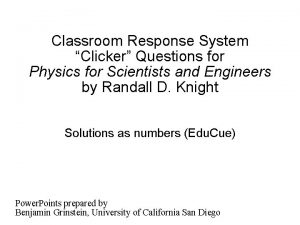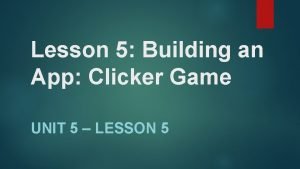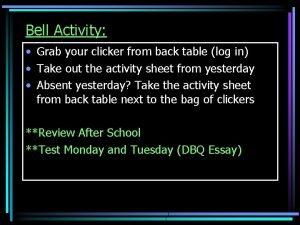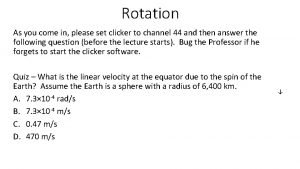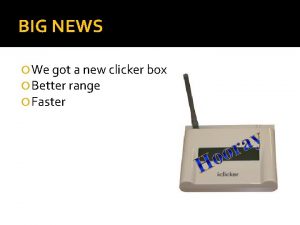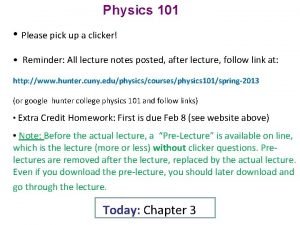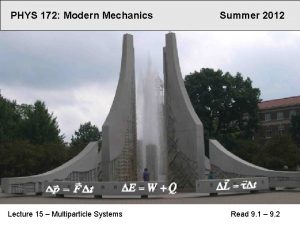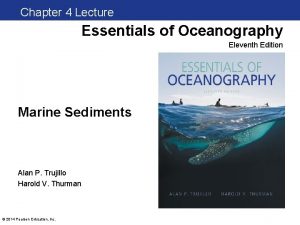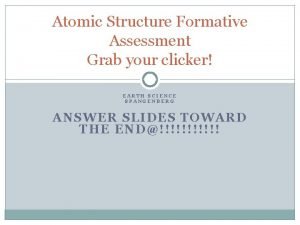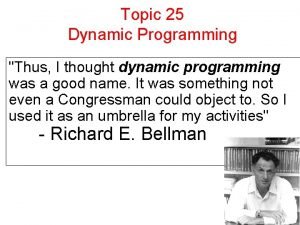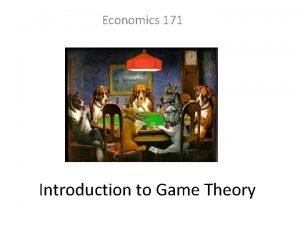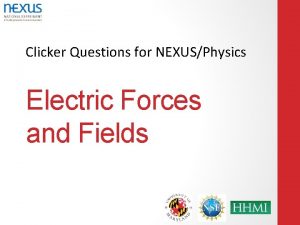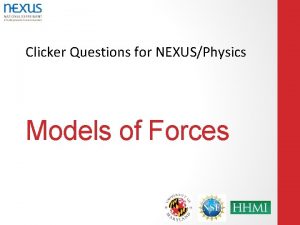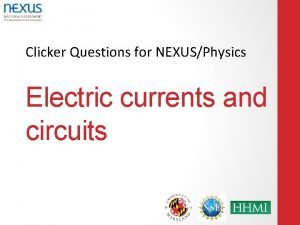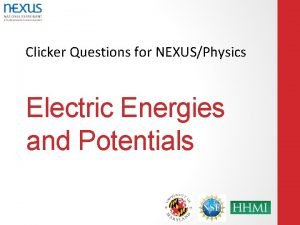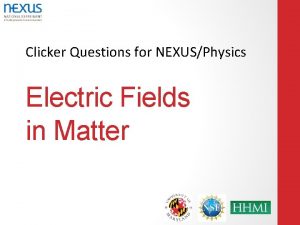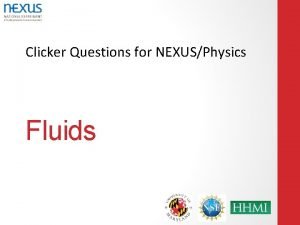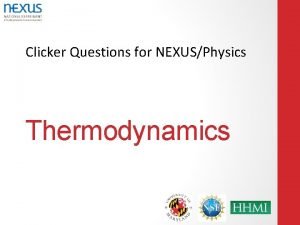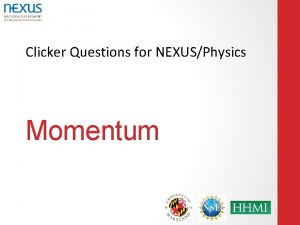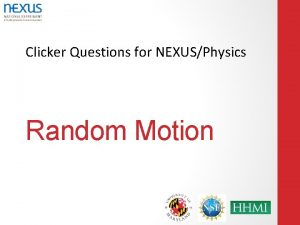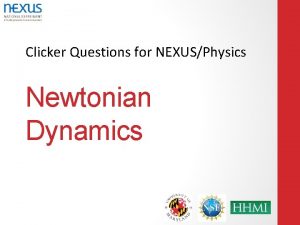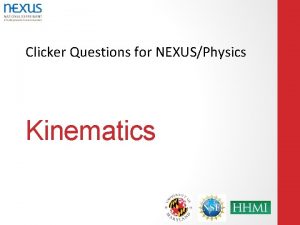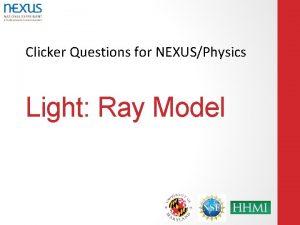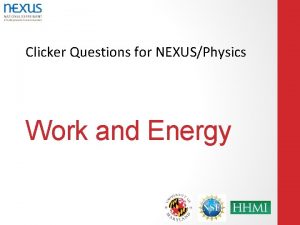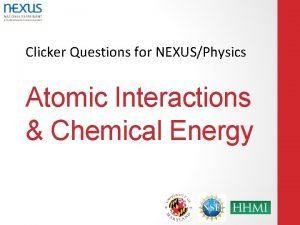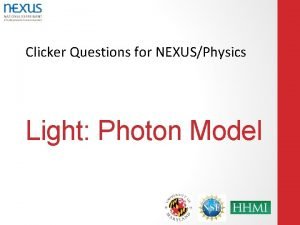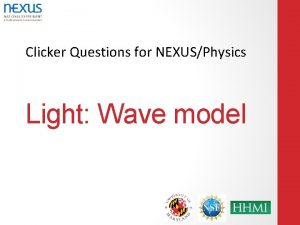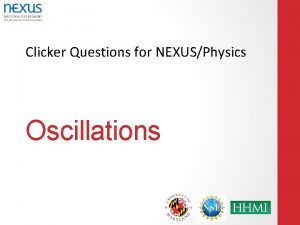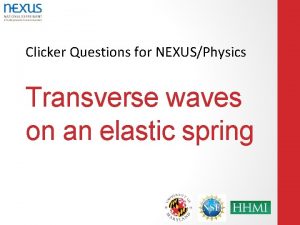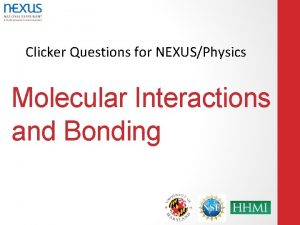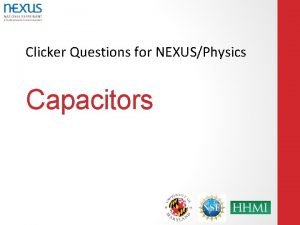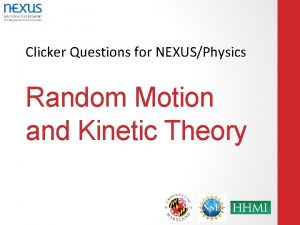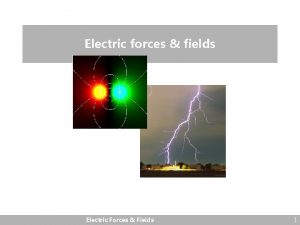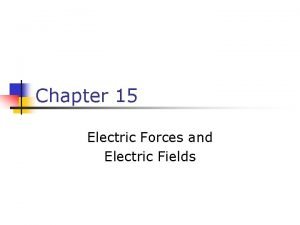Clicker Questions for NEXUSPhysics Electric Forces A note

































- Slides: 33

Clicker Questions for NEXUS/Physics Electric Forces

A note on usage: The clicker slides in this booklet are meant to be used as stimuli to encourage class discussion. They are intended for use in a class that attempts to help students develop a coherent and sophisticated understanding of scientific thinking. They are NOT intended as items to test whether students are “right or wrong” or “know” the correct answer by one-step recall if enough cues are given. This has a number of instructional implications that are reviewed in general on the next four slides. The individual slides also contain annotations discussing their intended use.

Usage: 1 • Feedback One of the most important values of a clickerresponse system is to provide instructors with some understanding of what students are thinking. Good clicker questions can be highly revealing (and surprising). But the critical fact is not that the students make mistakes but to use those mistakes to probe their thinking and find out why. This raises the importance of a rich subsequent discussion well above “letting the students know what the right answer is. ”

Usage 2: • Student-student interactions The critical value for student learning occurs in what happens after a clicker question has obtained a mixed response from the students. The standard next cue is, “Find someone who disagreed with the answer you chose and see if you can convince them. ” After a minute or two of discussion, a second click may show students having moved dramatically towards the correct answer. A brief call for who changed their answer and why can lead to a useful exchange. When they have not moved significantly, more discussion is called for.

Usage: 3 • Incompletely specified questions Some items have questions that are simple if idealized assumptions are made, subtler if they are not. Part of the discussion of these items are intended to include issues of modeling, idealizations, and hidden assumptions. • Questions where answers are not provided. In these items, the intent is to have students come up with potential answers and have the instructor collect them and write them on the board. Occasionally, especially at the beginning of a class, it may take some time before students are willing to contribute answers. It can help if you have some prepared answers ready, walk around the class, and put up the answers as if they came from the students. This can help students get more comfortable with contributing.

Usage: 4 • Cluster questions Some questions are meant to be used as part of a group of questions. In this case, resolving the answers to individual questions is better left until the entire group is completed. The value of the questions are often in the comparison of the different items and in having students think about what changes lead to what differences and why. • Problem solving items In these items (indicated by a pencil cluster logo), the intent is to have students work together to solve some small problem. After a few minutes, ask the groups to share their answers, vote on the different answers obtained, and have a discussion.

A student suspends a small piece of aluminum foil by a light insulating thread, holds the foil between her fingers for a moment, then releases it. The aluminum foil is then attracted towards a charged comb. Before it actually touches the comb, the foil most likely_____. A. is neutral B. has the same charge as the comb C. has a charge opposite to the comb’s

A small piece of aluminum foil suspended by a light insulating thread is attracted towards a charged comb. Suppose that instead of the comb you used a glass rod, which is charged oppositely to the comb. In this case, the aluminum foil would ______. A. be attracted towards the glass rod B. be repelled by the glass rod C. do neither D. you can’t tell from the information given ?

A + charged object is placed near a conductor attached to an insulating pedestal (a). After the opposite side of the conductor is grounded for a short time (b), the conductor becomes negatively charged (c). Based on this information, we can conclude that within the conductor 1. 2. 3. 4. both + and - charges move freely only + charges move freely We can’t really conclude anything from the information given.

Two uniformly charged spheres are firmly fastened to and electrically insulated from frictionless pucks on an air table. The charge on sphere 2 is three times the charge on sphere 1. Which force diagram correctly shows the relative magnitude and direction of the electrostatic forces

Three pithballs are suspended from thin threads. Various objects are then rubbed against other objects (nylon against silk, glass against polyester, etc. ) and each of the pithballs is charged by touching them with one of these objects. It is found that pithballs 1 and 2 repel each other and that pithballs 2 and 3 repel each other. From this we can conclude that 1. 2. 3. 4. 5. 1 and 3 carry charges of opposite sign. 1 and 3 carry charges of equal sign. All three carry the charges of the same sign. One of the objects carries no charge. We need to do more experiments to determine the sign of the charges.

Three pithballs are suspended from thin threads. Various objects are then rubbed against other objects (nylon against silk, glass against polyester, etc. ) and each of the pithballs is charged by touching them with one of these objects. It is found that pithballs 1 and 2 attract each other and that pithballs 2 and 3 repel each other. From this we can conclude that 1. 2. 3. 4. 5. 1 and 3 carry charges of opposite sign. 1 and 3 carry charges of equal sign. All three carry the charges of the same sign. One of the objects carries no charge. We need to do more experiments to determine the sign of the charges.

Two identical conductors hang from nonconducting strings. They are given charges q 1 = Q and q 2 = 3 Q. After charging, the two strings make angles of θ 1 and θ 2 with the vertical. How do the angles compare? 1. 2. 3. 4. θ 1 > θ 2 θ 1 < θ 2 θ 1 = θ 2 You don’t have enough information to tell.

Three identical charges are lined up in a row. If we compare the electric force charge q 1 exerts on charge q 3 (F 1 → 3) to the force q 2 exerts on charge q 3 (F 2→ 3) A. B. C. D. E. F 1→ 3 is twice as big as F 2→ 3. F 1→ 3 is half as big as F 2→ 3. F 1→ 3 is more than twice as big as F 2→ 3. F 1→ 3 is less than half as big as F 2→ 3. F 1→ 3 doesn’t affect q 3 at all since q 2 is in the way.

In the figure are shown four arrangements of charge. Each charge has the same magnitude, but some are + and some are -. All distances are to the same scale. In which would the magnitude of the force felt by a positive test charge placed at P be the largest? A. B. C. D. E. A B C D You can’t tell.

In the figure are shown four arrangements of charge. Each charge has the same magnitude, but some are + and some are -. All distances are to the same scale. In which would the magnitude of the force felt by a positive test charge placed at P be the smallest? A. B. C. D. E. A B C D You can’t tell.

Find the magnitude and direction of the force the charge Q exerts on the dipole.

In the figure below are shown four two-dimensional arrangements of charge. Each of the charges has the same magnitude, but some are positive and some are negative. In each diagram a point is labeled “P”. Rank the diagrams by the magnitude of the force felt by a positive test charge placed at P.

A test charge (labeled q) is placed in a situation in which it feels the electrical force from three other charges (of opposite sign to it) labeled A, B, and C. (The charges are on a uniform grid as shown and the positions are to scale. ) Which of the following combinations of forces has the greatest magnitude? 1. 2. 3. 4. There is not enough information to tell.

A test charge, q, is a distance d from a charge Q as shown. It feels an electric field, E 0. If q were replaced by a charge – 3 q, the electric field on it would 1. 2. 3. 4. 5. 6. Change to -3 E 0 Change to -E 0/3 Not change Change to 3 E 0 Change to E 0/3 Something else

A test charge, q, is a distance d from a charge Q as shown. It feels an electric force, F 0. If q were replaced by a charge – 3 q, the electric force on it would 1. 2. 3. 4. 5. 6. Change to -3 F 0 Change to -F 0/3 Not change Change to 3 F 0 Change to F 0/3 Something else

Choose the letter corresponding to the direction of the net electric force exerted by a charge Q on a 3 -charge molecule with the charge distribution shown if Q is positive.

Choose the letter corresponding to the direction of the net electric force exerted by the molecule on the charge Q if Q is positive.

Choose the letter corresponding to the direction of the net electric force exerted by a charge Q on a 3 -charge molecule with the charge distribution shown if Q is negative.

Choose the letter corresponding to the direction of the net electric force exerted by the molecule on the charge Q if Q is negative.

Three molecules are shown, each made up of two positive ions (+e) and a negative ion (-2 e). What is the direction of the net electrical force on a positive charge placed at the x in situation #1? A. B. C. D. E. F. points to the left (←), points to the right (→), points up (↑), points down (↓), is zero (0) Cannot be determined from the information given.

Three molecules are shown, each made up of two positive ions (+e) and a negative ion (-2 e). What is the direction of the net electrical force on a positive charge placed at the x in situation #2? A. B. C. D. E. F. points to the left (←), points to the right (→), points up (↑), points down (↓), is zero (0) Cannot be determined from the information given.

Three molecules are shown, each made up of two positive ions (+e) and a negative ion (-2 e). What is the direction of the net electrical force on a positive charge placed at the x in situation #3? A. B. C. D. E. F. points to the left (←), points to the right (→), points up (↑), points down (↓), is zero (0) Cannot be determined from the information given.

Three molecules are shown, each made up of two positive ions (+e) and a negative ion (-2 e). What is the relation between the magnitude of the force on a positive test charge at the x from the negative ion B to the magnitude of the force from the positive ion C ? A. B. C. D. The forces are the same; The force from B is greater; The force from C is greater; Cannot be determined from the information given.

Three molecules are shown, each made up of two positive ions (+e) and a negative ion (-2 e). What is the relation between the magnitude of the force on a positive test charge at the x from the negative ion H to the magnitude of the force from the two positives ion GH ? A. B. C. D. The forces are the same; The force from B is greater; The force from C is greater; Cannot be determined from the information given.

In each of the four cases shown below, a particle of charge +q is placed a distance d from a particle of charge +4 q. The particles are then released simultaneously. The masses of the particles are indicated in the diagram. Which case has the largest magnitude of the acceleration of the RIGHT HAND particle just after it is released? (Click all if there are more than one. ) A. B. C. D. Case 1 Case 2 Case 3 Case 4

In the figure are shown four arrangements of charge. Each charge has the same magnitude, but some are + and some are -. All distances are to the same scale. If the positive test charge, P, is replaced by a negative one, what happens to the direction of the electric force it feels? 1. The force stays the same 2. The force reverses 3. The force changes magnitude 4. You can’t tell.

In the figure are shown four arrangements of charge. Each charge has the same magnitude, but some are + and some are -. All distances are to the same scale. If the positive test charge, P, is replaced by a negative one, what happens to the direction of the electric field it measures? 1. The force stays the same 2. The force reverses 3. The force changes magnitude 4. You can’t tell.
 Electric charges and electric forces lesson outline
Electric charges and electric forces lesson outline Clicker questions physics
Clicker questions physics Difference between note making and note taking
Difference between note making and note taking Signal words for cause and effect
Signal words for cause and effect Difference between note making and note taking
Difference between note making and note taking Goods received note
Goods received note Debit note example
Debit note example What is debit note and credit note
What is debit note and credit note Note taking and note making
Note taking and note making Loan x has a principal of $10 000x
Loan x has a principal of $10 000x Mathclicker
Mathclicker E clicker
E clicker Audience response clicker
Audience response clicker Lesson 5 building an app clicker game
Lesson 5 building an app clicker game Earth clicker
Earth clicker Maximal heart rate
Maximal heart rate Hitler clicker
Hitler clicker Clicker stop motion
Clicker stop motion Cooi clicker
Cooi clicker Umbc clicker
Umbc clicker Clicker box
Clicker box Roger rabbit
Roger rabbit Clicker stop motion
Clicker stop motion Clicker
Clicker Particl clicker
Particl clicker Buzka clicker
Buzka clicker Salt clicker
Salt clicker Clicker gravel transport
Clicker gravel transport Atomic clicker
Atomic clicker Spacebar click
Spacebar click Dynamic problem
Dynamic problem Clicker
Clicker Presentation clicker challenger
Presentation clicker challenger Cosine rule bbc
Cosine rule bbc

